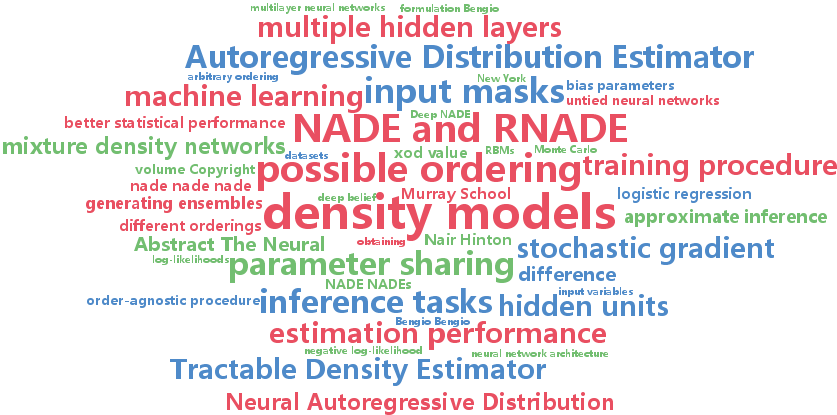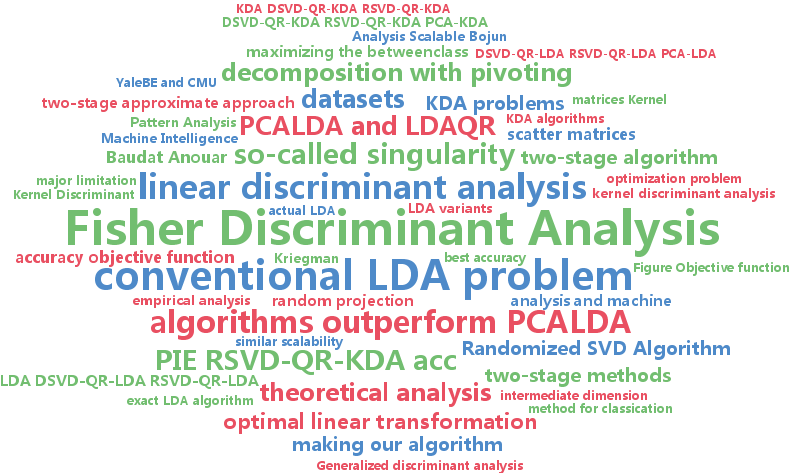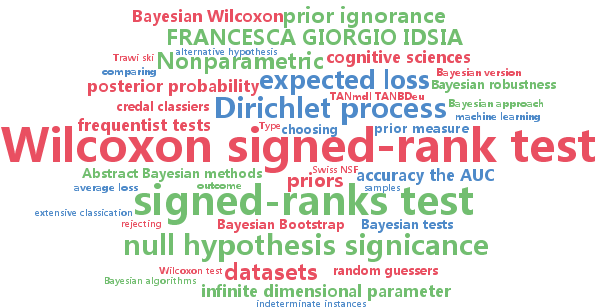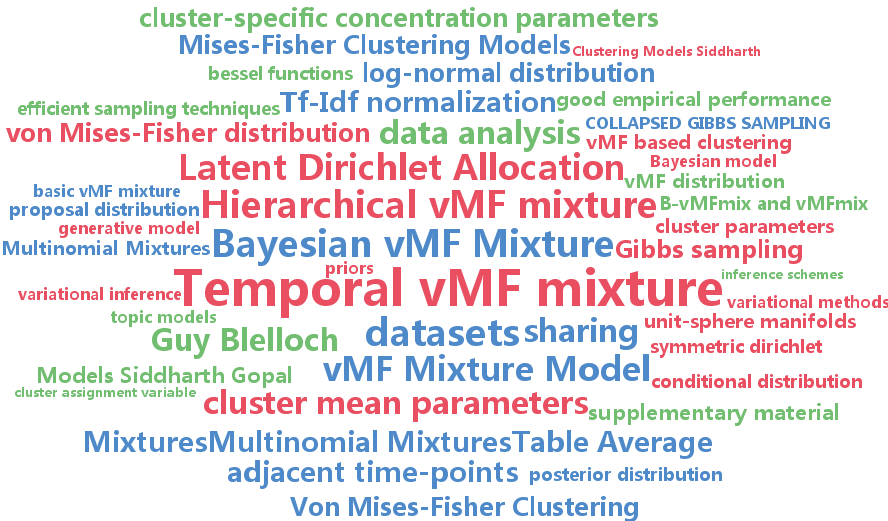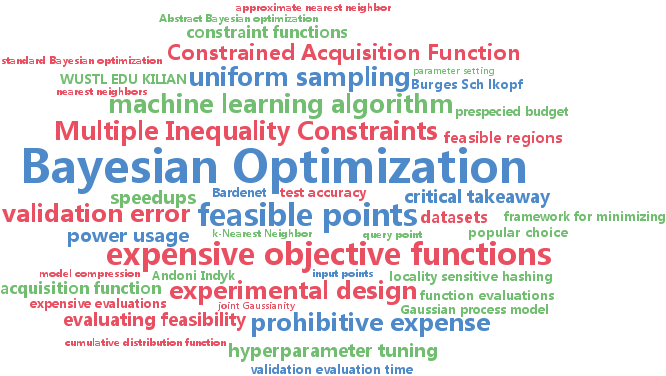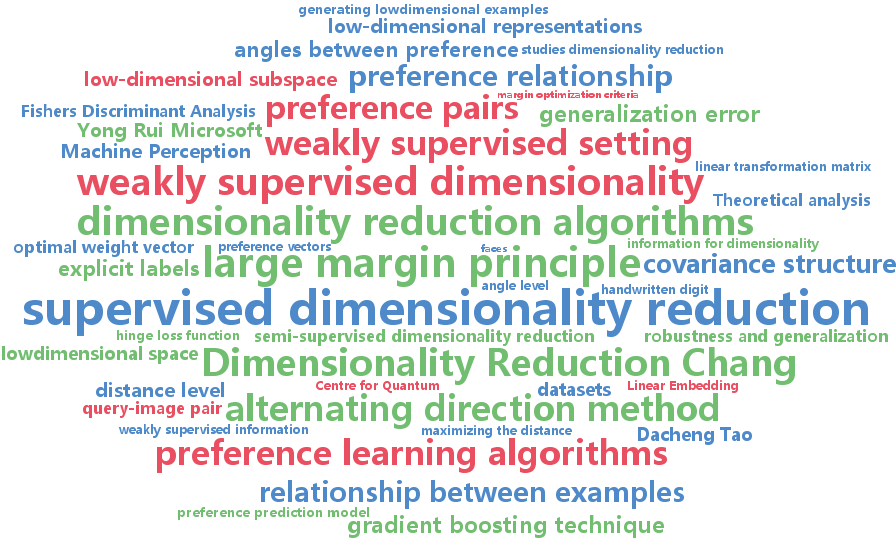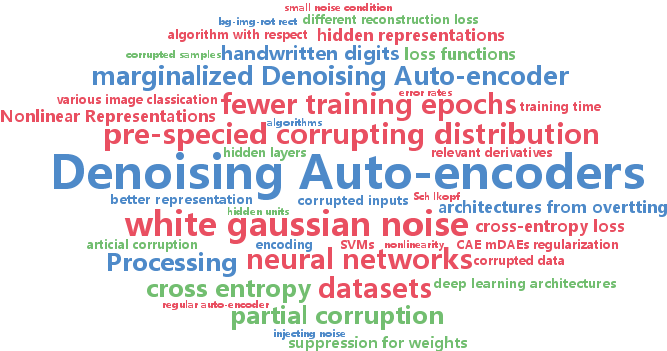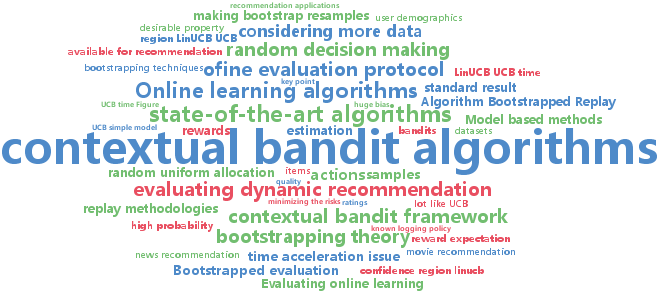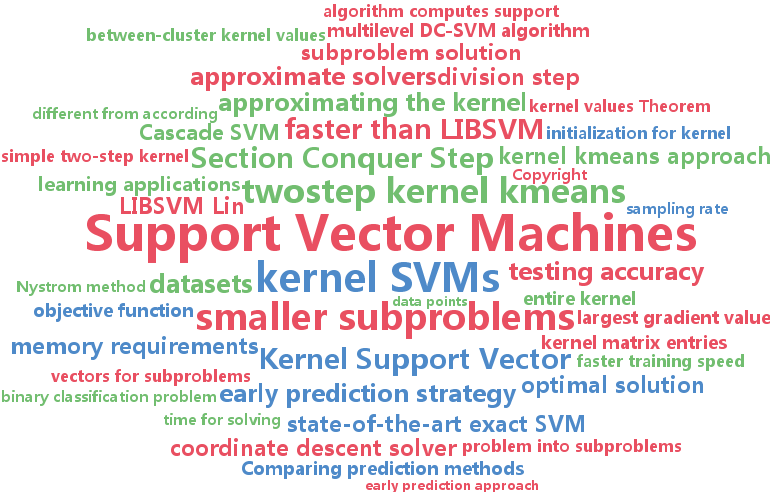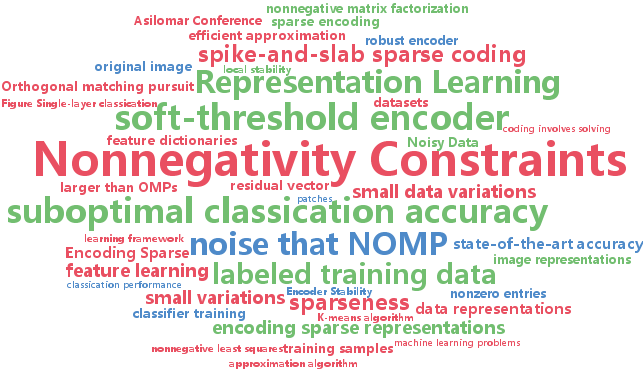datasets
-
David Knowles and Zoubin Ghahramani and Konstantina Palla
A reversible infinite HMM using normalised random measures (pdf)
We present a nonparametric prior over reversible Markov chains. We use completely random measures, specifically gamma processes, to construct a countably infinite graph with weighted edges. By enforcing symmetry to make the edges undirected we define a prior over random walks on graphs that results in a reversible Markov chain. The resulting prior over infinite transition matrices is closely related to the hierarchical Dirichlet process but enforces reversibility. A reinforcement scheme has recently been proposed with similar properties, but the de Finetti measure is not well characterised. We take the alternative approach of explicitly constructing the mixing measure, which allows more straightforward and efficient inference at the cost of no longer having a closed form predictive distribution. We use our process to construct a reversible infinite HMM which we apply to two real datasets, one from epigenomics and one ion channel recording.
-
Benigno Uria and Iain Murray and Hugo Larochelle
A Deep and Tractable Density Estimator (pdf)
The Neural Autoregressive Distribution Estimator (NADE) and its real-valued version RNADE are competitive density models of multidimensional data across a variety of domains. These models use a fixed, arbitrary ordering of the data dimensions. One can easily condition on variables at the beginning of the ordering, and marginalize out variables at the end of the ordering, however other inference tasks require approximate inference. In this work we introduce an efficient procedure to simultaneously train a NADE model for each possible ordering of the variables, by sharing parameters across all these models. We can thus use the most convenient model for each inference task at hand, and ensembles of such models with different orderings are immediately available. Moreover, unlike the original NADE, our training procedure scales to deep models. Empirically, ensembles of Deep NADE models obtain state of the art density estimation performance.
-
Bojun Tu and Zhihua Zhang and Shusen Wang and Hui Qian
Making Fisher Discriminant Analysis Scalable (pdf)
The Fisher linear discriminant analysis (LDA) is a classical method for classification and dimension reduction jointly. A major limitation of the conventional LDA is a so-called singularity issue. Many LDA variants, especially two-stage methods such as PCA+LDA and LDA/QR, were proposed to solve this issue. In the two-stage methods, an intermediate stage for dimension reduction is developed before the actual LDA method works. These two-stage methods are scalable because they are an approximate alternative of the LDA method. However, there is no theoretical analysis on how well they approximate the conventional LDA problem. In this paper we present theoretical analysis on the approximation error of a two-stage algorithm. Accordingly, we develop a new two-stage algorithm. Furthermore, we resort to a random projection approach, making our algorithm scalable. We also provide an implemention on distributed system to handle large scale problems. Our algorithm takes LDA/QR as its special case, and outperforms PCA+LDA while having a similar scalability. We also generalize our algorithm to kernel discriminant analysis, a nonlinear version of the classical LDA. Extensive experiments show that our algorithms outperform PCA+LDA and have a similar scalability with it.
-
Aaron Defazio and Justin Domke and tiberio Caetano
Finito: A faster, permutable incremental gradient method for big data problems (pdf)
Recent advances in optimization theory have shown that smooth strongly convex finite sums can be minimized faster than by treating them as a black box "batch" problem. In this work we introduce a new method in this class with a theoretical convergence rate four times faster than existing methods, for sums with sufficiently many terms. This method is also amendable to a sampling without replacement scheme that in practice gives further speed-ups. We give empirical results showing state of the art performance.
-
Alessio Benavoli and Giorgio Corani and Francesca Mangili and Marco Zaffalon and Fabrizio Ruggeri
A Bayesian Wilcoxon signed-rank test based on the Dirichlet process (pdf)
Bayesian methods are ubiquitous in machine learning. Nevertheless, the analysis of empirical results is typically performed by frequentist tests. This implies dealing with null hypothesis significance tests and p-values, even though the shortcomings of such methods are well known. We propose a nonparametric Bayesian version of the Wilcoxon signed-rank test using a Dirichlet process (DP) based prior. We address in two different ways the problem of how to choose the infinite dimensional parameter that characterizes the DP. The proposed test has all the traditional strengths of the Bayesian approach; for instance, unlike the frequentist tests, it allows verifying the null hypothesis, not only rejecting it, and taking decision which minimize the expected loss. Moreover, one of the solutions proposed to model the infinitedimensional parameter of the DP, allows isolating instances in which the traditional frequentist test is guessing at random. We show results dealing with the comparison of two classifiers using real and simulated data.
-
Siddharth Gopal and Yiming Yang
Von Mises-Fisher Clustering Models (pdf)
This paper proposes a suite of models for clustering high-dimensional data on a unit sphere based on Von Mises-Fisher (vMF) distribution and for discovering more intuitive clusters than existing approaches. The proposed models include a) A Bayesian formulation of vMF mixture that enables information sharing among clusters, b) a Hierarchical vMF mixture that provides multi-scale shrinkage and tree structured view of the data and c) a Temporal vMF mixture that captures evolution of clusters in temporal data. For posterior inference, we develop fast variational methods as well as collapsed Gibbs sampling techniques for all three models. Our experiments on six datasets provide strong empirical support in favour of vMF based clustering models over other popular tools such as K-means, Multinomial Mixtures and Latent Dirichlet Allocation.
-
Jacob Gardner and Matt Kusner and Zhixiang and Kilian Weinberger and John Cunningham
Bayesian Optimization with Inequality Constraints (pdf)
Bayesian optimization is a powerful framework for minimizing expensive objective functions while using very few function evaluations. It has been successfully applied to a variety of problems, including hyperparameter tuning and experimental design. However, this framework has not been extended to the inequality-constrained optimization setting, particularly the setting in which evaluating feasibility is just as expensive as evaluating the objective. Here we present constrained Bayesian optimization, which places a prior distribution on both the objective and the constraint functions. We evaluate our method on simulated and real data, demonstrating that constrained Bayesian optimization can quickly find optimal and feasible points, even when small feasible regions cause standard methods to fail.
-
Chang Xu and Dacheng Tao and Chao Xu and Yong Rui
Large-margin Weakly Supervised Dimensionality Reduction (pdf)
This paper studies dimensionality reduction in a weakly supervised setting, in which the preference relationship between examples is indicated by weak cues. A novel framework is proposed that integrates two aspects of the large margin principle (angle and distance), which simultaneously encourage angle consistency between preference pairs and maximize the distance between examples in preference pairs. Two specific algorithms are developed: an alternating direction method to learn a linear transformation matrix and a gradient boosting technique to optimize a non-linear transformation directly in the function space. Theoretical analysis demonstrates that the proposed large margin optimization criteria can strengthen and improve the robustness and generalization performance of preference learning algorithms on the obtained low-dimensional subspace. Experimental results on real-world datasets demonstrate the significance of studying dimensionality reduction in the weakly supervised setting and the effectiveness of the proposed framework.
-
Minmin Chen and Kilian Weinberger and Fei Sha and Yoshua Bengio
Marginalized Denoising Auto-encoders for Nonlinear Representations (pdf)
Denoising auto-encoders (DAEs) have been successfully used to learn new representations for a wide range of machine learning tasks. During training, DAEs make many passes over the training dataset and reconstruct it from partial corruption generated from a pre-specified corrupting distribution. This process learns robust representation, though at the expense of requiring many training epochs, in which the data is explicitly corrupted. In this paper we present the marginalized Denoising Auto-encoder (mDAE), which (approximately) marginalizes out the corruption during training. Effectively, the mDAE takes into account infinitely many corrupted copies of the training data in every epoch, and therefore is able to match or outperform the DAE with much fewer training epochs. We analyze our proposed algorithm and show that it can be understood as a classic auto-encoder with a special form of regularization. In empirical evaluations we show that it attains 1-2 order-of-magnitude speedup in training time over other competing approaches.
-
Jérémie Mary and Philippe Preux and Olivier Nicol
Improving offline evaluation of contextual bandit algorithms via bootstrapping techniques (pdf)
In many recommendation applications such as news recommendation, the items that can be recommended come and go at a very fast pace. This is a challenge for recommender systems (RS) to face this setting. Online learning algorithms seem to be the most straight forward solution. The contextual bandit framework was introduced for that very purpose. In general the evaluation of a RS is a critical issue. Live evaluation is often avoided due to the potential loss of revenue, hence the need for offline evaluation methods. Two options are available. Model based methods are biased by nature and are thus difficult to trust when used alone. Data driven methods are therefore what we consider here. Evaluating online learning algorithms with past data is not simple but some methods exist in the literature. Nonetheless their accuracy is not satisfactory mainly due to their mechanism of data rejection that only allow the exploitation of a small fraction of the data. We precisely address this issue in this paper. After highlighting the limitations of the previous methods, we present a new method, based on bootstrapping techniques. This new method comes with two important improvements: it is much more accurate and it provides a measure of quality of its estimation. The latter is a highly desirable property in order to minimize the risks entailed by putting online a RS for the first time. We provide both theoretical and experimental proofs of its superiority compared to state-of-the-art methods, as well as an analysis of the convergence of the measure of quality.
-
Claudio Gentile and Shuai Li and Giovanni Zappella
Online Clustering of Bandits (pdf)
We introduce a novel algorithmic approach to content recommendation based on adaptive clustering of exploration-exploitation (``bandit") strategies. We provide a sharp regret analysis of this algorithm in a standard stochastic noise setting, demonstrate its scalability properties, and prove its effectiveness on a number of artificial and real-world datasets. Our experiments show a significant increase in prediction performance over state-of-the-art methods for bandit problems.
-
Cho-Jui Hsieh and Si Si and Inderjit Dhillon
A Divide-and-Conquer Solver for Kernel Support Vector Machines (pdf)
The kernel support vector machine (SVM) is one of the most widely used classification methods; however, the amount of computation required becomes the bottleneck when facing millions of samples. In this paper, we propose and analyze a novel divide-and-conquer solver for kernel SVMs (DC-SVM). In the division step, we partition the kernel SVM problem into smaller subproblems by clustering the data, so that each subproblem can be solved independently and efficiently. We show theoretically that the support vectors identified by the subproblem solution are likely to be support vectors of the entire kernel SVM problem, provided that the problem is partitioned appropriately by kernel clustering. In the conquer step, the local solutions from the subproblems are used to initialize a global coordinate descent solver, which converges quickly as suggested by our analysis. By extending this idea, we develop a multilevel Divide-and-Conquer SVM algorithm with adaptive clustering and early prediction strategy, which outperforms state-of-the-art methods in terms of training speed, testing accuracy, and memory usage. As an example, on the covtype dataset with half-a-million samples, DC-SVM is 7 times faster than LIBSVM in obtaining the exact SVM solution (to within 10^{-6
-
Tsung-Han Lin and H. T. Kung
Stable and Efficient Representation Learning with Nonnegativity Constraints (pdf)
Orthogonal matching pursuit (OMP) is an efficient approximation algorithm for computing sparse representations. However, prior research has shown that the representations computed by OMP may be of inferior quality, as they deliver suboptimal classification accuracy on several im- age datasets. We have found that this problem is caused by OMP's relatively weak stability under data variations, which leads to unreliability in supervised classifier training. We show that by imposing a simple nonnegativity constraint, this nonnegative variant of OMP (NOMP) can mitigate OMP's stability issue and is resistant to noise overfitting. In this work, we provide extensive analysis and experimental results to examine and validate the stability advantage of NOMP. In our experiments, we use a multi-layer deep architecture for representation learning, where we use K-means for feature learning and NOMP for representation encoding. The resulting learning framework is not only efficient and scalable to large feature dictionaries, but also is robust against input noise. This framework achieves the state-of-the-art accuracy on the STL-10 dataset.
-
Ting Zhang and Chao Du and Jingdong Wang
Composite Quantization for Approximate Nearest Neighbor Search (pdf)
This paper presents a novel compact coding approach, composite quantization, for approximate nearest neighbor search. The idea is to use the composition of several elements selected from the dictionaries to accurately approximate a vector and to represent the vector by a short code composed of the indices of the selected elements. To efficiently compute the approximate distance of a query to a database vector using the short code, we introduce an extra constraint, constant inter-dictionary-element-product, resulting in that approximating the distance only using the distance of the query to each selected element is enough for nearest neighbor search. Experimental comparison with state-of-the-art algorithms over several benchmark datasets demonstrates the efficacy of the proposed approach.

